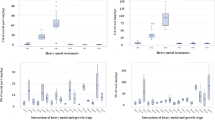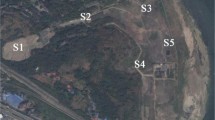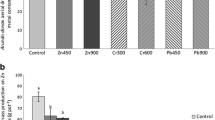Abstract
Soil contamination with heavy metals and metalloids is a global concern nowadays. Phytoremediation is an eco-friendly, cost-effective, and sustainable way of mitigating such contamination by utilizing the plants’ ability to accumulate, sequester, and stabilize elements. Biomass-producing plants may outperform hyperaccumulators in terms of total elemental removal and offer more cost-effectiveness through their usable biomass. Ipomoea carnea is a wild plant in the Asian region. It is resilient, spreads rapidly in a wide range of soil conditions, and has a high potential for biomass feedstock. In this work, we have tested this plant species for its growth performance and accumulation characteristics of Cr and As. In a pot experiment, the plants could easily grow from rootless stem segments in 2 weeks when garden soils are treated with 100–500 ppm of Cr and 20–300 ppm of As. Plant growth reduction was little at the moderate level of these elements, with a significant accumulation of elements in 45 days. Within this time, in the stems and leaves, the Cr concentrations were found to be 49 and 39 ppm, respectively, when treated with 500 ppm of Cr, whereas the As concentrations were obtained as 83 and 28 ppm, respectively, for the treatment with 300 ppm of As. To estimate the biomass production potential, the plant was grown with a density of 80,000 per ha under normal field conditions (without metal stress). At the harvest, the plants consisted of 80% stems, 11% leaves, and 9% belowground portions on a dry weight basis. The dry weight of stems, leaves, and belowground parts was 31.3%, 17.9%, and 23.7%, respectively. Overall, the estimated biomass was 25.8 Mg/ha/year from three harvests. The ability to regrow from the basal part makes it useful for continuous sequestration of toxic elements over multiple harvests. Our results show that I. carnea could lower Cr and As from contaminated soils and potentially a phytoremediation candidate considering accumulation rate and high amount of usable biomass production.




Similar content being viewed by others
Data availability
Not applicable.
References
Abba HM, Lucky Y (2016) Investigation on the mechanism of erosion control of Ipomoea carnea Jacq. (Kafi Kancila/KasheKwari) in Gombe State, Nigeria. Int J Sci Res 7:167–173
Abhilash PC, Yunus M (2011) Can we use biomass produced from phytoremediation? Biomass Bioenergy 35:1371–1372
Ahmad FD, Ahmad N, Masood KR, Hussain M, Malik MF, Qayyum A (2018) Phytoremediation of arsenic-contaminated soils by Eucalyptus camaldulensis, Terminalia arjuna and Salix tetrasperma. J Appl Bot Food Qual 91:8–13
Ahmad A, Khan WU, Shah AA, Yasin NA, Naz S, Ali A, Tahir A, Batool AI (2021) Synergistic effects of nitric oxide and silicon on promoting plant growth, oxidative stress tolerance and reduction of arsenic uptake in Brassica juncea. Chemosphere 262:128384
Ali H, Khan E, Sajad MA (2013) Phytoremediation of heavy metals-concepts and applications. Chemosphere 91:869–881
Beans C (2017) Phytoremediation advances in the lab but lags in the field. Proc Natl Acad Sci 114(29):7475–7477
Bertin PN, Crognale S, Plewniak F, Battaglia-Brunet F, Rossetti S, Mench M (2021) Water and soil contaminated by arsenic: the use of microorganisms and plants in bioremediation. Environ Sci Pollut Res 2:1–28
Billah MM, Kokushi E, Uno S (2019) Distribution, geochemical speciation, and bioavailable potencies of cadmium, copper, lead, and zinc in sediments from urban coastal environment in Osaka Bay, Japan. Water Air Soil Pollut 230:1–3
Boe A, Owens VN, Gonzalez-Hernandez JL, Stein J, Lee DK, Koo BC (2009) Morphology and biomass production of prairie cordgrass on marginal lands. GCB Bioenergy 1(3):240–250
Brand-Williams W, Cuvelier ME, Berset CL (1995) Use of a free radical method to evaluate antioxidant activity. LWT 28(1):25–30
Chen G, Zou X, Zhou Y, Zhang J, Owens G (2014) A short-term study to evaluate the uptake and accumulation of arsenic in Asian willow (Salix sp.) from arsenic-contaminated water. Environ Sci Pollut Res 21:3275–3284
Ciurli A, Lenzi L, Alpi A, Pardossi A (2014) Arsenic uptake and translocation by plants in pot and field experiment. Int J Phytoremediation 16(7–8):804–823
Duxbury JM, Panaullah G (2007) Remediation of arsenic for agriculture sustainability, food security and health in Bangladesh. FAO Water Working Paper. FAO, Rome. URL: https://www.fao.org/3/ap102e/ap102e.pdf. Accessed 15 Feb 2022
Faizan M, Sehar S, Rajput VD, Faraz A, Afzal S, Minkina T, Sushkova S, Adil MF, Yu F, Alatar AA, Akhter F (2021) Modulation of cellular redox status and antioxidant defense system after synergistic application of zinc oxide nanoparticles and salicylic acid in rice (Oryza sativa) plant under arsenic stress. Plants 10(11):2254
Ganesh PS, Sanjeevi R, Gajalakshmi S, Ramasamy EV, Abbasi SA (2008) Recovery of methane-rich gas from solid-feed anaerobic digestion of ipomoea (Ipomoea carnea). Bioresour Technol 99:812–818
Giannoulis KD, Karyotis T, Sakellariou-Makrantonaki M, Bastiaans L, Struik PC, Danalatos NG (2016) Switch grass biomass partitioning and growth characteristics under different management practices. NJAS Wageningen J Life Sci 78:61–67
Giorgio G, Sebastiani L (2006) Metal accumulation in poplar plant grown with industrial wastes. Chemosphere 64:446–454
Gohari G, Zareei E, Kulak M, Labib P, Mahmoudi R, Panahirad S, Jafari H, Mahdavinia G, Juárez-Maldonado A, Lorenzo JM (2021) Improving the berry quality and antioxidant potential of flame seedless grapes by foliar application of chitosan-phenylalanine nanocomposites (CS-Phe NCs). Nanomaterials 11(9):2287
Gomes MP, Nogueira MD, Castro EM, Soares ÂM (2011) Eco-physiological and anatomical changes due to uptake and accumulation of heavy metal in Brachiaria decumbens. Sci Agric 68:566–573
Harine IJ, Islam MR, Hossain M, Afroz H, Jahan R, Siddique AB, Uddin S, Hossain MA, Alamri S, Siddiqui MH et al (2021) Arsenic accumulation in rice grain as influenced by water management: human health risk assessment. Agronomy 11:1741
Hasan AB, Reza AH, Kabir S, Siddique M, Bakar A, Ahsan M, Akbor M (2020) Accumulation and distribution of heavy metals in soil and food crops around the ship breaking area in southern Bangladesh and associated health risk assessment. SN Appl Sci 2:1–8
Jahiruddin M, Xie Y, Ozaki A, Islam MR, Nguyen TV, Kurosawa K (2017) Arsenic, cadmium, lead and chromium concentrations in irrigated and rain-fed rice and their dietary intake implications. Aust J Crop Sci 11:806–812
Jiang Y, Lei M, Duan L, Longhurst P (2015) Integrating phytoremediation with biomass valorisation and critical element recovery: a UK contaminated land perspective. Biomass Bioenergy 83:328–339
Kassaye G, Gabbiye N, Alemu A (2017) Phytoremediation of chromium from tannery wastewater using local plant species. Water Pract Technol 12:894–901
Kormoker T, Proshad R, Islam MS, Tusher TR, Uddin M, Khadka S, Chandra K, Sayeed A (2020) Presence of toxic metals in rice with human health hazards in Tangail district of Bangladesh. Int J Environ Health Res 8:1–21
Kundu D, Dey S, Raychaudhuri SS (2018) Chromium (VI)-induced stress response in the plant Plantago ovata Forsk. in vitro. Genes Environ 40:1–3
López-Bucio JS, Ravelo-Ortega G, López-Bucio J (2022) Chromium in plant growth and development: Toxicity, tolerance and hormesis. Environ Pollut 312:120084
Nur-E-Alam M, Sayid MM, Ahmad F, Rahman MM (2020) An overview of chromium removal techniques from tannery effluent. Appl Water Sci 10:1–22
Patnaik AR, Achary VM, Panda BB (2013) Chromium (VI)-induced hormesis and genotoxicity are mediated through oxidative stress in root cells of Allium cepa L. Plant Growth Regul 71:157–170
Qu M, Li W, Zhang C, Huang B, Zhao Y (2015) Assessing the pollution risk of soil chromium based on loading capacity of paddy soil at a regional scale. Sci Rep 5:1–8
Rahman MA, Alam I, Sharmin SA, Kabir AH, Kim YG, Liu G, Lee BH (2021) Physiological and proteomic analyses reveal the protective roles of exogenous hydrogen peroxide in alleviating drought stress in soybean plants. Plant Biotechnol Rep 15:805–818
Shah AA, Shah AN, Bilal Tahir M, Abbas A, Javad S, Ali S, Rizwan M, Alotaibi SS, Kalaji HM, Telesinski A, Javed T (2022) Harzianopyridone supplementation reduced chromium uptake and enhanced activity of antioxidant enzymes in Vigna radiata seedlings exposed to chromium toxicity. Front Plant Sci 13:1524
Shaltout KH, Al-Sodany YM, Eid EM (2010) Growth behavior of the invasive species Ipomoea carnea in the Nile Delta. Egypt Hydrobiologia 656:187–197
Shankar S, Shanker US (2014) Arsenic contamination of groundwater: a review of sources, prevalence, health risks, and strategies for mitigation. Sci World J 2014:304524
Sharma A, Kapoor D, Wang J, Shahzad B, Kumar V, Bali AS, Jasrotia S, Zheng B, Yuan H, Yan D (2020) Chromium bioaccumulation and its impacts on plants: an overview. Plants 9:100
Sharmin SA, Alam I, Kim KH, Kim YG, Kim PJ, Bahk JD, Lee BH (2012) Chromium-induced physiological and proteomic alterations in roots of Miscanthus sinensis. Plant Sci 187:113–126
Siddique MA, Alam MK, Islam S, Diganta MT, Akbor MA, Bithi UH, Chowdhury AI, Ullah AA (2020) Apportionment of some chemical elements in soils around the coal mining area in northern Bangladesh and associated health risk assessment. Environ Nanotechnol Monit Manag 14:100366
Singh S, Srivastava PK, Kumar D, Tripathi DK, Chauhan DK, Prasad SM (2015) Morpho-anatomical and biochemical adapting strategies of maize (Zea mays L.) seedlings against lead and chromium stresses. Biocatal Agric Biotechnol 4(3):286–95
Taufikurahman T, Pradisa MAS, Amalia SG, Hutahaean GEM (2019) Phytoremediation of chromium (Cr) using Typha angustifolia L., Canna indica L. and Hydrocotyle umbellata L. in surface flow system of constructed wetland. IOP Conf Ser: Earth Environ Sci 308:012020
Tőzsér D, Horváth R, Simon E, Magura T (2023) Heavy metal uptake by plant parts of Populus species: a meta-analysis. Environ Sci Pollut Res 30(26):69416–69430
Truta E, Mihai C, Gherghel D, Vochita G (2014) Assessment of the cytogenetic damage induced by chromium short-term exposure in root tip meristems of barley seedlings. Water Air Soil Pollut 225:1–2
United States Department of Energy (US DOE) (2006) Breaking the biological barriers to cellulosic ethanol: a joint research agenda. DOE/SC-0095, US DOE Off. Sci. and Off. Energy Effic and Renewable Energy. URL: http://www.doegenomestolife.org/biofuels/. Accessed 15 Feb 2022
Williams PN, Villada A, Deacon C, Raab A, Figuerola J, Green AJ, Feldmann J, Meharg AA (2007) Greatly enhanced arsenic shoot assimilation in rice leads to elevated grain levels compared to wheat and barley. Environ Sci Technol 41:6854–6859
Acknowledgements
The authors are grateful to the authority of the National Institute of Biotechnology, Savar, Dhaka, Bangladesh, and the Institute of National Analytical Research and Service (INARS), Bangladesh Council of Scientific and Industrial Research (BCSIR), Dhaka, Bangladesh, for providing necessary facilities.
Funding
This work was supported by the Ministry of Science and Technology, The People’s Republic of Bangladesh through Special Allocation for Science & Technology Programme (grant references: 39.00.0000.009.06.2017/2; grant recipient: S.A. Sharmin). SS Sarker is a recipient of NIB Thesis Studentship and NIB Research Fellowship (ref: 39.06.2672.001.11.012.21.1511(4)) from the National Institute of Biotechnology.
Author information
Authors and Affiliations
Contributions
SS Sarker: methodology, formal analysis, investigation, data curation. S Akter: methodology, validation, formal analysis, investigation, data curation. MAB Siddique: methodology, validation, formal analysis, investigation, data curation, reviewing and editing of the manuscript draft, visualization. S Nahar: methodology, investigation, KMJ Rahman: methodology, formal analysis, SA Sharmin: conceptualization, funding acquisition, project administration, research supervision, writing original draft. All authors read and approved the final version of the manuscript.
Corresponding author
Ethics declarations
Ethical approval
Not applicable.
Consent to participate
Not applicable.
Consent for publication
All authors read the manuscript and gave their consent to its submission to Environmental Science and Pollution Research for publication.
Competing interests
The authors declare no competing interests.
Additional information
Responsible Editor: Elena Maestri
Publisher's note
Springer Nature remains neutral with regard to jurisdictional claims in published maps and institutional affiliations.
Supplementary Information
Below is the link to the electronic supplementary material.
Rights and permissions
Springer Nature or its licensor (e.g. a society or other partner) holds exclusive rights to this article under a publishing agreement with the author(s) or other rightsholder(s); author self-archiving of the accepted manuscript version of this article is solely governed by the terms of such publishing agreement and applicable law.
About this article
Cite this article
Sarker, S.S., Akter, S., Siddique, M.A.B. et al. Chromium and arsenic bioaccumulation and biomass potential of pink morning glory (Ipomoea carnea Jacq.). Environ Sci Pollut Res 31, 2187–2197 (2024). https://doi.org/10.1007/s11356-023-31159-3
Received:
Accepted:
Published:
Issue Date:
DOI: https://doi.org/10.1007/s11356-023-31159-3




